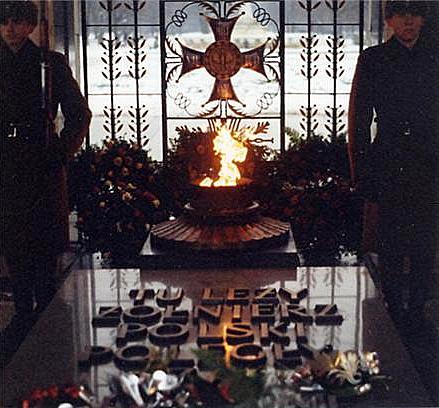|
Józef Piłsudski Monument (Piłsudski Square)
The Józef Piłsudski Monument in Warsaw was erected to honor Józef Piłsudski, a military leader, Marshal of Poland and one of the main figures responsible for Poland's regaining its independence. This tall, bronze and granite statue is located near Piłsudski's Square and the Hotel Europejski, at Tokarzewski-Karaszewicz Street. It bears the inscriptions "Józef Piłsudski" and "Marshal of Poland". Plans to raise the monument can be traced to 1990, when the president of Warsaw Stanisław Wyganowski endorsed the request of a group campaigning for the creation of a monument to Piłsudski. The monument, cast in the Polish Navy Shipyards, was unveiled on 14 August 1995, on the 75th anniversary of the Battle of Warsaw, which was commanded by Piłsudski. The unveiling was attended by the President of Poland, Lech Wałęsa, and Piłsudski's daughter, Jadwiga Piłsudska. The original plans called for the monument to be raised at Na Rozdrożu Square, but were later modified to site ... [...More Info...] [...Related Items...] OR: [Wikipedia] [Google] [Baidu] |
Piłsudski Square
Piłsudski Square (), is the largest city square of Poland's capital, located in the Warsaw city centre. The square is named after Marshal Józef Piłsudski who was instrumental in the restoration of Polish statehood after World War I. Official website. Current and previous names Over the centuries, the square has been named successively as Saxon Square (''Plac Saski'') after Poland's Saxon kings, with the Saxon Palace standing adjacent to the square, but destroyed in World War II; then Piłsudski Square (after ) during the |
Tomb Of The Unknown Soldier, Warsaw
The Tomb of the Unknown Soldier () is a monument in Warsaw, Poland, dedicated to the unknown soldiers who have given their lives for Poland. It is one of many such national tombs of unknowns that were erected after World War I, and the most important such monument in Poland. The monument, located at Piłsudski Square, is the only surviving part of the Saxon Palace that occupied the spot until World War II. Since 2 November 1925 the tomb houses the unidentified body of a young soldier who fell during the Defence of Lwów. Since then, earth from numerous battlefields where Polish soldiers have fought has been added to the urns housed in the surviving pillars of the Saxon Palace. The Tomb is constantly lit by an eternal flame and assisted by a guard post provided by the three companies of the 1st Guards Battalion, Representative Regiment of the Polish Armed Forces. It is there that most official military commemorations take place in Poland and where foreign representatives l ... [...More Info...] [...Related Items...] OR: [Wikipedia] [Google] [Baidu] |
Granite Sculptures In Poland
Granite ( ) is a coarse-grained (phanerite, phaneritic) intrusive rock, intrusive igneous rock composed mostly of quartz, alkali feldspar, and plagioclase. It forms from magma with a high content of silica and alkali metal oxides that slowly cools and solidifies underground. It is common in the continental crust of Earth, where it is found in igneous intrusions. These range in size from dike (geology), dikes only a few centimeters across to batholiths exposed over hundreds of square kilometers. Granite is typical of a larger family of ''granitic rocks'', or ''granitoids'', that are composed mostly of coarse-grained quartz and feldspars in varying proportions. These rocks are classified by the relative percentages of quartz, alkali feldspar, and plagioclase (the QAPF diagram, QAPF classification), with true granite representing granitic rocks rich in quartz and alkali feldspar. Most granitic rocks also contain mica or amphibole minerals, though a few (known as leucogranites) conta ... [...More Info...] [...Related Items...] OR: [Wikipedia] [Google] [Baidu] |

